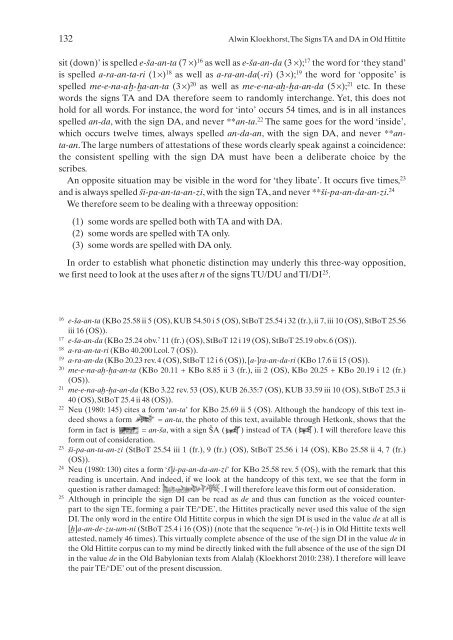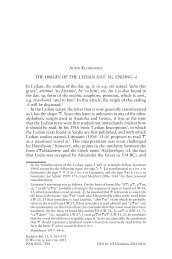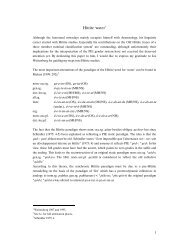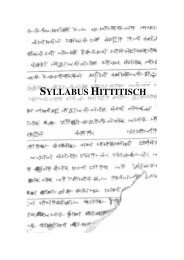The signs TA and DA in Old Hittite: evidence for a ... - Alwin Kloekhorst
The signs TA and DA in Old Hittite: evidence for a ... - Alwin Kloekhorst
The signs TA and DA in Old Hittite: evidence for a ... - Alwin Kloekhorst
- No tags were found...
Create successful ePaper yourself
Turn your PDF publications into a flip-book with our unique Google optimized e-Paper software.
132Alw<strong>in</strong> <strong>Kloekhorst</strong>,<strong>The</strong> Signs <strong>TA</strong> <strong>and</strong> <strong>DA</strong> <strong>in</strong> <strong>Old</strong> <strong>Hittite</strong>sit (down)’ is spelled e-ša-an-ta (7 ×) 16 as well as e-ša-an-da (3 ×); 17 the word <strong>for</strong> ‘they st<strong>and</strong>’is spelled a-ra-an-ta-ri (1×) 18 as well as a-ra-an-da(-ri) (3 ×); 19 the word <strong>for</strong> ‘opposite’ isspelled me-e-na-a˘h-˘ha-an-ta (3 ×) 20 as well as me-e-na-a˘h-˘ha-an-da (5 ×); 21 etc. In thesewords the <strong>signs</strong> <strong>TA</strong> <strong>and</strong> <strong>DA</strong> there<strong>for</strong>e seem to r<strong>and</strong>omly <strong>in</strong>terchange. Yet, this does nothold <strong>for</strong> all words. For <strong>in</strong>stance, the word <strong>for</strong> ‘<strong>in</strong>to’ occurs 54 times, <strong>and</strong> is <strong>in</strong> all <strong>in</strong>stancesspelled an-da, with the sign <strong>DA</strong>, <strong>and</strong> never **an-ta. 22 <strong>The</strong> same goes <strong>for</strong> the word ‘<strong>in</strong>side’,which occurs twelve times, always spelled an-da-an, with the sign <strong>DA</strong>, <strong>and</strong> never **anta-an.<strong>The</strong>large numbers of attestations of these words clearly speak aga<strong>in</strong>st a co<strong>in</strong>cidence:the consistent spell<strong>in</strong>g with the sign <strong>DA</strong> must have been a deliberate choice by thescribes.An opposite situation may be visible <strong>in</strong> the word <strong>for</strong> ‘they libate’. It occurs five times, 23<strong>and</strong> is always spelled ši-pa-an-ta-an-zi, with the sign <strong>TA</strong>, <strong>and</strong> never **ši-pa-an-da-an-zi. 24We there<strong>for</strong>e seem to be deal<strong>in</strong>g with a threeway opposition:(1) some words are spelled both with <strong>TA</strong> <strong>and</strong> with <strong>DA</strong>.(2) some words are spelled with <strong>TA</strong> only.(3) some words are spelled with <strong>DA</strong> only.In order to establish what phonetic dist<strong>in</strong>ction may underly this three-way opposition,we first need to look at the uses after n of the <strong>signs</strong> TU/DU <strong>and</strong> TI/DI 25 .16e-ša-an-ta (KBo 25.58 ii 5 (OS), KUB 54.50 i 5 (OS), StBoT 25.54 i 32 (fr.), ii 7, iii 10 (OS), StBoT 25.56iii 16 (OS)).17e-ša-an-da (KBo 25.24 obv. ? 11 (fr.) (OS), StBoT 12 i 19 (OS), StBoT 25.19 obv. 6 (OS)).18a-ra-an-ta-ri (KBo 40.200 l.col. 7 (OS)).19a-ra-an-da (KBo 20.23 rev. 4 (OS), StBoT 12 i 6 (OS)), [a-]ra-an-da-ri (KBo 17.6 ii 15 (OS)).20 a-an-ta (KBo 20.11 + KBo 8.85 ii 3 (fr.), iii 2 (OS), KBo 20.25 + KBo 20.19 i 12 (fr.)me-e-na-ah˘ -h˘(OS)).21 a-an-da (KBo 3.22 rev. 53 (OS), KUB 26.35:7 (OS), KUB 33.59 iii 10 (OS), StBoT 25.3 iime-e-na-ah˘ -h˘40 (OS), StBoT 25.4 ii 48 (OS)).22Neu (1980: 145) cites a <strong>for</strong>m ‘an-ta’ <strong>for</strong> KBo 25.69 ii 5 (OS). Although the h<strong>and</strong>copy of this text <strong>in</strong>deedshows a <strong>for</strong>m = an-ta, the photo of this text, available through Hetkonk, shows that the<strong>for</strong>m <strong>in</strong> fact is = an-ša, with a sign ŠA ( ) <strong>in</strong>stead of <strong>TA</strong> ( ). I will there<strong>for</strong>e leave this<strong>for</strong>m out of consideration.23ši-pa-an-ta-an-zi (StBoT 25.54 iii 1 (fr.), 9 (fr.) (OS), StBoT 25.56 i 14 (OS), KBo 25.58 ii 4, 7 (fr.)(OS)).24Neu (1980: 130) cites a <strong>for</strong>m ‘š]i-pạ-an-da-an-zi’ <strong>for</strong> KBo 25.58 rev. 5 (OS), with the remark that thisread<strong>in</strong>g is uncerta<strong>in</strong>. And <strong>in</strong>deed, if we look at the h<strong>and</strong>copy of this text, we see that the <strong>for</strong>m <strong>in</strong>question is rather damaged:. I will there<strong>for</strong>e leave this <strong>for</strong>m out of consideration.25Although <strong>in</strong> pr<strong>in</strong>ciple the sign DI can be read as de <strong>and</strong> thus can function as the voiced counterpartto the sign TE, <strong>for</strong>m<strong>in</strong>g a pair TE/‘DE’, the <strong>Hittite</strong>s practically never used this value of the signDI. <strong>The</strong> only word <strong>in</strong> the entire <strong>Old</strong> <strong>Hittite</strong> corpus <strong>in</strong> which the sign DI is used <strong>in</strong> the value de at all is]a-an-de-zu-um-ni (StBoT 25.4 i 16 (OS)) (note that the sequence °n-te(-) is <strong>in</strong> <strong>Old</strong> <strong>Hittite</strong> texts well[h˘attested, namely 46 times). This virtually complete absence of the use of the sign DI <strong>in</strong> the value de <strong>in</strong>the <strong>Old</strong> <strong>Hittite</strong> corpus can to my m<strong>in</strong>d be directly l<strong>in</strong>ked with the full absence of the use of the sign DI<strong>in</strong> the value de <strong>in</strong> the <strong>Old</strong> Babylonian texts from (<strong>Kloekhorst</strong> 2010: 238). I there<strong>for</strong>e will leaveAlalah˘the pair TE/‘DE’ out of the present discussion.






